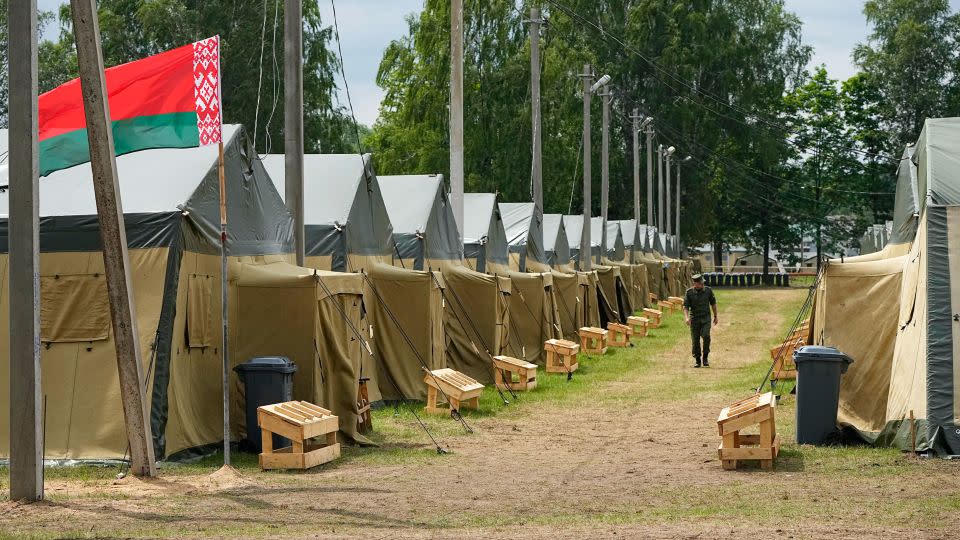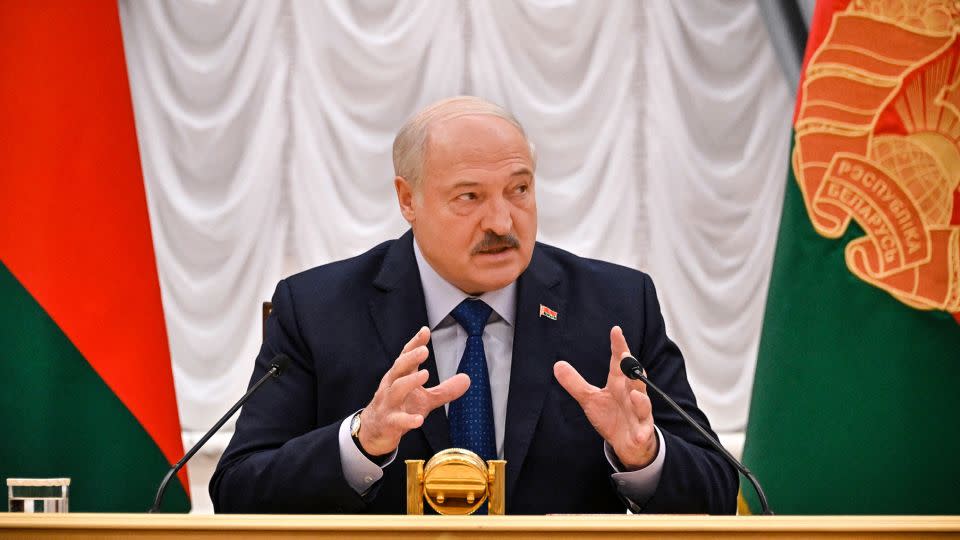Western intel officials hunt for signs of Wagner and nuclear warheads in Belarus ahead of NATO
In the wake of the uprising by Wagner Group forces in Russia, the US and Europe have turned their gaze to an increasingly unpredictable Belarus – a key Russian ally that Western officials fear could give the exiled mercenary troops a new home and serve as a staging ground for Russian nuclear weapons.
But so far, US and European officials have not seen clear signs that either scenario is unfolding. While officials are closely monitoring an apparent military camp that sprung up outside of Minsk following the uprising in southern Russia, Wagner troops do not appear to have moved into the country en masse.
“It could happen that Wagner PMC decides not to relocate here,” Belarusian President Alexander Lukashenko said on Thursday. Wagner leader Yevgeny Prigozhin is not even in Belarus, Lukashenko told CNN – he is in Russia, Lukashenko claimed.

And while Russian President Vladimir Putin said last month that the facilities in Belarus necessary to store the tactical nuclear weapons would be ready by July 7, Western officials have seen no signs of that, either. Belarus still does not appear to have the proper infrastructure to house the weapons, officials said, and it will likely be months, if not longer, before doing so is even technically feasible.
Available satellite imagery has also not shown any signs of the kind of preparations and security that would be standard at a Russian nuclear facility. Russia has the world’s largest arsenal of nuclear weapons, with 4,477 deployed and reserve nuclear warheads, including around 1,900 tactical nuclear weapons, according to the Federation of American Scientists. It is not clear how many of those Russia is potentially planning to deploy to Belarus.
“We are in this fog of Russian mirrors. What actions will Putin take? We don’t know,” said Max Bergmann, the director of Russian and European studies at the Center for Strategic and International Studies.
“Putin does not need tactical nuclear weapons in Belarus to use those weapons,” Bergmann added. “But it is concerning to the US that tactical nuclear weapons could potentially be co-located in Belarus with Wagner fighters. That said, it seems there is a long way to go before we would even get there.”
Russian nuclear command and control
US officials still have questions about how Russia would protect its potential arsenal in Belarus from rogue actors. The concerns have not set off a five-alarm fire within the US government, however, officials feel confident that when it comes to command and control, it is in Putin’s interest to keep both Wagner fighters and Lukashenko from having any access to Russia’s nuclear arsenal.
The 12th Main Directorate of the Ministry of Defense has controlled Russia’s nuclear arsenal since the collapse of the Soviet Union. Experts say it would be surprising if another body was assigned control of any tactical nuclear warheads in Belarus. A senior officer from the Directorate did travel to Belarus in the spring.
Still, Lukashenko’s close relationship with Putin, and the unexpected role he played in quelling the Wagner uprising, has left intelligence analysts vigilant about what could come next and is a key topic of discussion among NATO allies ahead of next week’s leaders summit in Vilnius, Lithuania. And some US officials are also concerned that Putin could make an announcement related to Russia’s presence in Belarus during the summit.

But even without any major announcement from Russia next week, the alliance is already on edge about Wagner potentially expanding to Belarus: Poland is demanding additional funding from the European Union to bolster its border security amid fears that Wagner will reconstitute in neighboring Belarus. Latvia’s prime minister said Wagner could attempt to infiltrate Europe from a new perch in Belarus. And Lithuania’s president described Wagner fighters as “serial killers” who could “emerge in Belarus at any moment. And nobody knows when they could turn against us.”
The countries’ presidents wrote a letter to the NATO secretary general and the heads of the NATO alliance on Friday, warning them about the threat “posed by Russia’s aggressive actions and the evolving situation in Belarus.”
“The cooperation between Russia and Belarus has deteriorated the security of the region and that of the entire Euro-Atlantic area,” they wrote, according to the Lithuanian President’s Communication Group.
“The Russians moving even a part of its nuclear arsenal to Belarus is something new, we don’t know what the intention is, so the Poles are right to be concerned,” said Angela Stent, the director of Russian studies at Georgetown University. “This is part of the nuclear brinkmanship that Putin has engaged with from the beginning of the war.”
Signs of Wagner in Belarus
US and European officials have not seen signs that Wagner troops have retreated to Belarus in large numbers, and it does not even appear that Prigozhin is in the country himself. Lukashenko told CNN on Thursday that Prigozhin is currently in St. Petersburg, Russia, despite striking a deal with Putin nearly two weeks ago in which he agreed to be exiled to Belarus for his role in staging the Wagner uprising.
Officials have been closely monitoring signs that a military garrison around 50 miles southeast of Minsk is being revived, possibly for use by Wagner forces. The Belarusian government on Friday gave foreign media, including CNN, a tour of the garrison, which could be used to house Wagner fighters if they come to the country.
The work on the field camp appears to predate the uprising, officials said. And Belarusian Major General Leonid Kasinsky told CNN on Friday that “there is absolutely no connection between this camp and Wagner.” He added that “yesterday the President said that if Yevgeny Prigozhin makes a decision together with his commanders to come to Belarus to set up, then this camp among other places could be offered to them.”
With Prigozhin now cut off from much, if not all, of his funding from the Kremlin, however, it is not clear he can sustain a large Wagner contingent inside Belarus – or that Lukashenko would allow him to do so, knowing that he could pose a threat to his rule.
The Belarusian leader said that if Wagner did relocate to Belarus, they would have to sign a contract with the Belarusian government – something Prigozhin refused to do with the Russian Ministry of Defense before staging his attempted insurrection in Russia last month.
“When they decide to be located in Belarus, we will draft up a contract with them,” Lukashenko said on Thursday. “Everything will be spelled out in it. The framework within which this unit will operate will be determined at the level of a law or a presidential decree.”
For more CNN news and newsletters create an account at CNN.com
